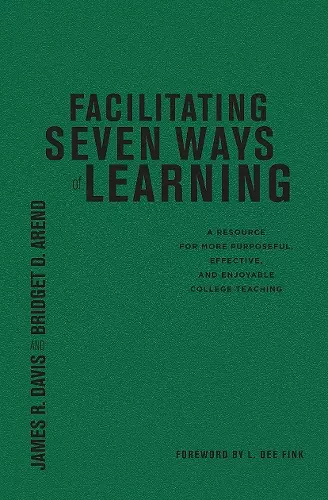Facilitating Seven Ways of Learning
A Resource for More Purposeful, Effective, and Enjoyable College Teaching
James R Davis author Bridget D Arend author
Format:Hardback
Publisher:Taylor & Francis Inc
Published:16th Oct '12
Currently unavailable, and unfortunately no date known when it will be back
This hardback is available in another edition too:
- Paperback£31.99(9781579228415)

For teachers in higher education who haven’t been able to catch up with developments in teaching and learning, James Davis and Bridget Arend offer an introduction that focuses on seven coherent and proven evidence-based strategies. The underlying rationale is to provide a framework to match teaching goals to distinct ways of learning, based on well-established theories of learning. The authors present approaches that readers can readily and safely experiment with to achieve desired learning outcomes, and build confidence in changing their methods of teaching.Research on learning clearly demonstrates that learning is not one thing, but many. The learning associated with developing a skill is different from the learning associated with understanding and remembering information, which in turn is different from thinking critically and creatively, solving problems, making decisions, or change paradigms in the light of evidence. Differing outcomes involve different ways of learning and teaching strategies.The authors provide the reader with a conceptual approach for selecting appropriate teaching strategies for different types of content, and for achieving specific learning objectives. They demonstrate through examples how a focused and purposeful selection of activities improves student performance, and in the process makes for a more effective and satisfying teaching experience.The core of the book presents a chapter on each of the seven ways of learning. Each chapter offers a full description of the process, illustrates its application with examples from different academic fields and types of institutions, clearly describes the teacher’s facilitation role, and covers assessment and online use.The seven ways of learning are: Behavioral Learning; Cognitive Learning; Learning through Inquiry; Learning with Mental Models; Learning through Groups and Teams; Learning through Virtual Realities; and Experiential Learning.Along the way, the authors provide the reader with a basis for evaluating other approaches to teaching and other learning methodologies so that she or he can confidently go beyond the “seven ways” to adapt or adopt further strategies. This is the ideal companion for teachers who are beginning to explore new ways of teaching, and want to do some serious independent thinking about learning. The book can also be used to prepare graduate students for teaching, and will be welcomed by centers for teaching and learning to help continuing faculty re-examine a particular aspect of their teaching.
"“Slam dunk, touchdown, goal, grand slam, ace!!! This book is fabulous. Davis and Arend have pulled together an exceptional resource for better understanding effective teaching strategies by demonstrating how to adjust teaching based on what students need to learn. As faculty, we expect students to learn a wide variety of concepts, processes, and applications. To accomplish this, research clearly suggests using a variety of strategies. This book not only explains that research, but also gives concrete examples and a solid rationale for each learning approach.
While the authors note this material is not intended for those brand new to teaching, and although I believe just about anyone teaching at the postsecondary level could learn from this book, the primary audience really is faculty who are looking to rethink what they are currently doing. This book will result in seriously reassessing how to best facilitate learning.
This is the perfect book for groups and reading circles of experienced teachers. I will certainly add to my faculty development collection.”
Todd Zakrajsek, Associate Professor, School of Medicine, University of North Carolina at Chapel Hill
"The seven ways of learning identified by Davis and Arend will add a great deal of precision to the task of selecting the right set of learning activities for a rich, or in my language, significant set of learning goals.
Another feature of this book that adds major value is the fact that the authors clearly understand the important relationships in learning-centered, integrated course design. Therefore for each of the seven ways of learning, i.e., the seven sets of learning activities, they comment on the learning goals and the assessment activities that are appropriate for that way of learning.
For those of us who care about our students’ learning – and I believe that is the attitude of the majority of teachers – this book offers valuable strategies for improving learning, and will be worth reading for years to come!"
L. Dee Fink
"In a crowded marketplace of snake oil cure-alls for Higher Education comes this refreshingly straight-forward, sensible, and practical guide for college teachers. As Davis and Arend point out, learning is not just one thing, but many. Learning a skill is different from learning information, which is different form learning to think critically or creatively. It follows that there cannot be one way to teach it all. With careful attention to the research about multiple types of learning, Davis and Arend have provided a treasure trove of tips and techniques, from low-tech engaging discussions to high-tech virtual reality simulations, to help college teachers create learning environments that work."
Michael Wesch, 2008 US Professor of the Year, University Distinguished Teaching Scholar, Kansas State University
"When I saw the first drafts of this book I wanted to reach out and applaud. It is particularly welcome to find a volume that encourages us to slough off past habits and look to the students' learning. It's not easy; it's not comfortable and at times it feels anything but secure, but the students gain by it and even enjoy learning. Davis and Arend's book has much to offer the international reader, as well as the American one. Although soundly based on theory, this book is a practical primer for university teachers anywhere and everywhere."
C. Bland Tomkinson,FHEA FAUA, Honorary Visiting Pedagogic Development Adviser, Faculty of EPS, Visiting Lecturer, School of MACE, University of Manchester
ISBN: 9781579228408
Dimensions: unknown
Weight: 598g
326 pages